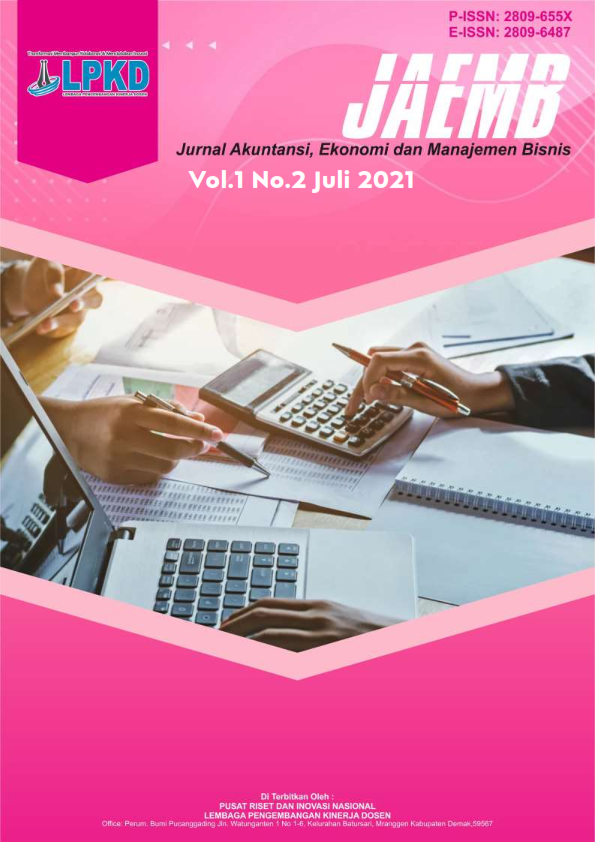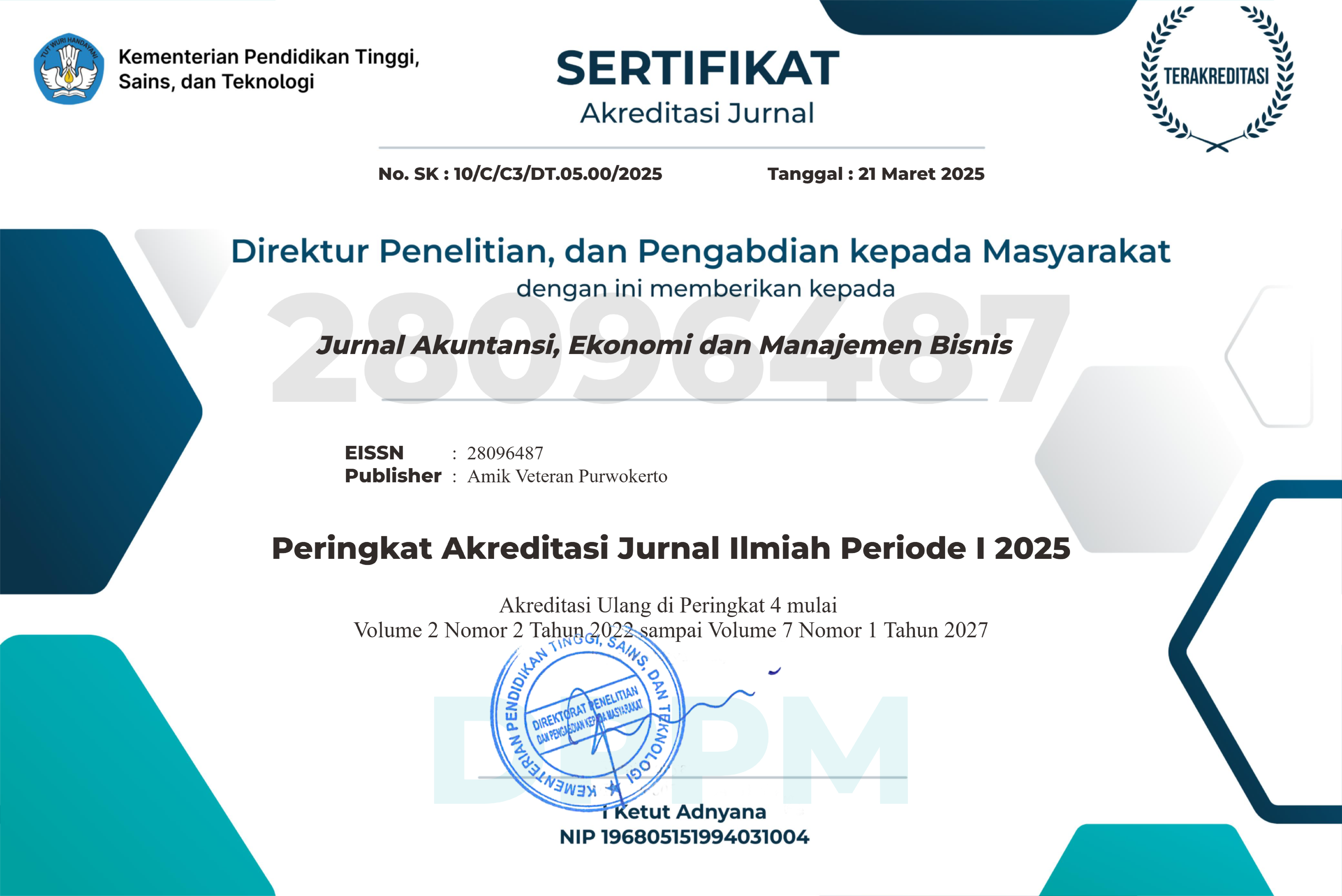THE DYNAMICS OF INCOME INEQUALITY IN THE SOLO RAYA REGION, 2008-2020
DOI:
https://doi.org/10.55606/jaem.v1i2.101Keywords:
income inequality, growth of the manufacturing sector, human development index, inflationAbstract
This study examines the effect of growth of the manufacturing sector, the human development index, and inflation on income inequality in the Solo Raya Region in 2008-2020. This study used panel data analysis with six districts and one city member of the Solo Raya Region. The data analysis stage was a selection test of the estimation technique and the classical assumption test to produce the best panel data regression model with the SUR cross-section weight. The regression estimation shows that the growth of the manufacturing sector and inflation positively and significantly affect income inequality. The human development index shows a negative and significant impact on income inequality. This analysis indicates that the economic development process in the Solo Raya region is in line with the development stages based on Rostow's view. The positive relationship between growth in the manufacturing sector and income inequality shows similarities to Kuznets's hypothesis that income inequality will increase in the initial phase of economic growth.
References
Albanesi, S. (2007). Inflation and inequality. Journal of Monetary Economics, 54(4), 1088–1114. https://doi.org/10.1016/j.jmoneco.2006.02.009
Alkire, S. (2010). Human Development: Definitions, Critiques, and Related Concepts. In OPHI Working Paper (No. 36). https://doi.org/10.2139/ssrn.1815263
Arief, M. A. (2019). Upah Pekerja Kompetitif, Eksodus Pabrikan ke Jateng Kian Marak. https://ekonomi.bisnis.com/read/20191118/257/1171372/upah-pekerja-kompetitif-eksodus-pabrikan-ke-jateng-kian-marak
Aryono, A. M. (2009). Soloraya Jadi Tujuan Relokasi Industri Tekstil. https://www.solopos.com/soloraya-jadi-tujuan-relokasi-industri-tekstil-3981
Čadil, J., Petkovová, L., & Blatná, D. (2014). Human Capital, Economic Structure and Growth. Procedia Economics and Finance 12, 85–92. https://doi.org/10.1016/S2212-5671(14)00323-2
Dabla-Norris, E., Kochhar, K., Suphaphiphat, N., Ricka, F., & Tsounta, E. (2015). Causes and Consequences of Income Inequality: A Global Perspective. In Staff Discussion Notes (Vol. 15, Issue 13). International Monetary Fund. https://doi.org/10.5089/9781513555188.006
Easterly, W., & Fischer, S. (2001). Inflation and the Poor. Journal of Money, Credit and Banking, 33(2), 160–178. https://doi.org/10.2307/2673879
Faggian, A., Modrego, F., & Mccann, P. (2019). Human capital and regional development. In R. Capello & P. Nijkamp (Eds.), Handbook of Regional Growth and Development Theories: Revised and Extended Second Edition (2nd ed., pp. 149–171). Edward Elgar. https://doi.org/10.4337/9781788970020.00015
Fleisher, B., Li, H., & Zhao, M. Q. (2010). Human capital, economic growth, and regional inequality in China. Journal of Development Economics, 92(2), 215–231. https://doi.org/10.1016/j.jdeveco.2009.01.010
Hardoon, D., Fuentes-Nieva, R., & Ayele, S. (2016). An Economy for the 1%: How privilege and power in the economy drive extreme inequality and how this can be stopped. In OXFAM Briefing Papers (Vol. 210, Issue January 2016). Oxfam International. https://doi.org/10.21201/2016.592643
Haseeb, M., Suryanto, T., Hartani, N. H., & Jermsittiparsert, K. (2020). Nexus Between Globalization, Income Inequality and Human Development in Indonesian Economy: Evidence from Application of Partial and Multiple Wavelet Coherence. Social Indicators Research, 147(3), 723–745. https://doi.org/10.1007/s11205-019-02178-w
Herman, E. (2016). The Importance of the Manufacturing Sector in the Romanian Economy. Procedia Technology, 22, 976–983. https://doi.org/10.1016/j.protcy.2016.01.121
Kapoor, R. (2015). Creating jobs in India’s organised manufacturing sector. Indian Journal of Labour Economics, 58(3), 349–375. https://doi.org/10.1007/s41027-016-0032-5
Khattak, D., Muhammad, A., & Iqbal, K. (2014). Determining the Relationship between Income Inequality, Economic Growth & Inflation. International Journal of Social Economics, 1(3), 104–114.
Rahayu, T. (2019). Industri Tekstil Migrasi ke Wilayah Soloraya. http://www.koransolo.co/2019/03/21/industri-tekstil-migrasi-ke-wilayah-soloraya/
Rodionov, D. G., Kudryavtseva, T. J., & Skhvediani, A. E. (2018). Human development and income inequality as factors of regional economic growth. European Research Studies Journal, 21(Special Issue 2), 323–337.
Rubin, A., & Segal, D. (2015). The effects of economic growth on income inequality in the US. Journal of Macroeconomics, 45, 258–273. https://doi.org/10.1016/j.jmacro.2015.05.007
Shin, I. (2012). Income inequality and economic growth. Economic Modelling, 29(5), 2049–2057. https://doi.org/10.1016/j.econmod.2012.02.011
Siami-Namini, S., & Hudson, D. (2019). Inflation and income inequality in developed and developing countries. Journal of Economic Studies, 46(3), 611–632. https://doi.org/10.1108/JES-02-2018-0045
Thalassinos, E., Uǧurlu, E., & Muratoǧlu, Y. (2012). Income inequality and inflation in the EU. European Research Studies Journal, 15(1), 127–140. https://doi.org/10.35808/ersj/347
Todaro, M., & Smith, S. C. (2012). Economic Development (11th ed.). Addison-Wesley.
Yasmeen, G., Begum, R., & Mujtaba, B. G. (2011). Human Development Challenges and Opportunities in Pakistan: Defying Income Inequality and Poverty. Journal of Business Studies Quarterly, 2(3), 1–12.
Downloads
Published
How to Cite
Issue
Section
License
Copyright (c) 2021 Jurnal Akuntansi, Ekonomi dan Manajemen Bisnis

This work is licensed under a Creative Commons Attribution 4.0 International License.








